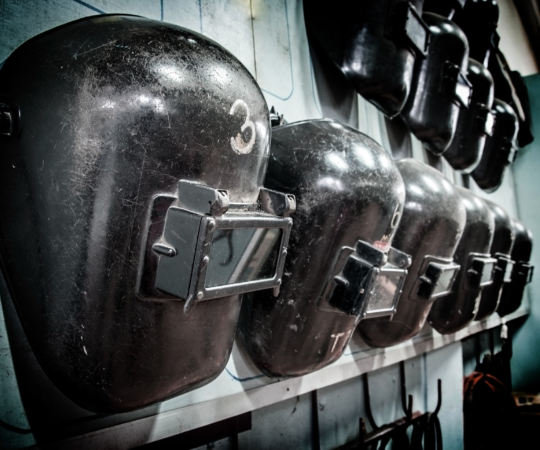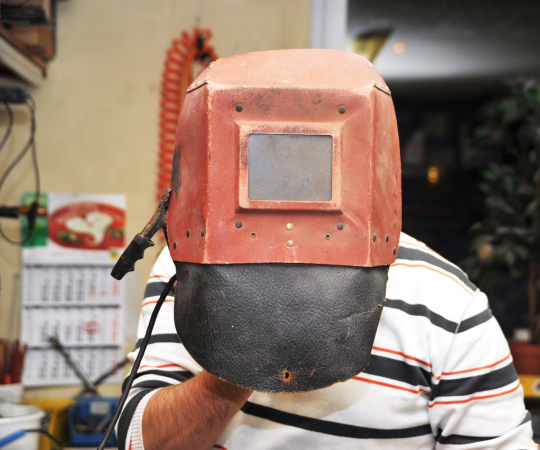Shielded Secrets: Crucial Safety Tips Behind the Welding Mask
You’ve probably seen a welder in action before. The sparks flying, the blue light flashing, and the hissing of gas – it’s an impressive sight. But have you ever stopped to think about the dangers that lie behind the welding mask? Welding can be a hazardous job if proper safety measures aren’t taken seriously.
Whether you’re a seasoned welder or just starting out, it’s important to understand that welding comes with risks. From burns to toxic fumes, there are several hazards that could put your health and safety at risk.
But don’t worry – by following some essential safety tips, you can protect yourself while on the job. In this article, we’ll explore some of the most important safety guidelines that every welder should know.
So grab your welding helmet and let’s get started!
Understand the Hazards of Welding
It’s crucial to recognize the potential dangers of welding and take necessary precautions to prevent harm. Welding safety gear is a must-have when it comes to protecting yourself from welding hazards.
From head to toe, you need protective equipment that will guard against heat, sparks, and flying debris. A welding helmet with a filtered lens protects your eyes, face, and neck from ultraviolet (UV) rays and infrared (IR) radiation.
Other essential safety gear includes fire-resistant clothing, gloves that can withstand high temperatures, and earplugs or earmuffs to protect your hearing from loud noises produced by the welding process.
Welding hazards explained include burns caused by hot metal or slag splatters, electric shock due to contact with live wires or faulty equipment, and respiratory issues caused by inhaling fumes or gases released during welding.
Proper ventilation is also crucial in preventing these risks as it removes harmful fumes and gases from the air you breathe while working on your project.
Proper Ventilation
You need to understand the dangers of fumes when welding and take proper precautions to avoid inhaling them. Fumes are produced from the welding process, and they can be hazardous to your health if you breathe them in over a prolonged period.
To prevent this, it’s essential to have proper ventilation in place while welding. This will help remove harmful fumes from the air and maintain a safe working environment.

Understanding the dangers of fumes
Breathing welding fumes can lead to serious health problems, so it’s important to understand the dangers and take precautions. The fumes released during welding contain harmful substances such as zinc oxide, aluminum oxide, and chromium that can cause respiratory issues like bronchitis or pneumonia when inhaled regularly. These fumes also have a negative impact on other parts of your body, including your eyes and skin.
Health effects from welding fumes can be reduced by using proper ventilation systems. Ventilation systems work by removing the contaminated air from the workspace and replacing it with fresh air. However, simply installing a ventilation system is not enough; you must ensure that it is properly maintained to prevent any leaks or clogs that may result in exposure to these harmful fumes.
In the next section, we will discuss best practices for ventilation that will help keep you safe while welding.
Best practices for ventilation
Properly maintaining a ventilation system is crucial for reducing the harmful effects of welding fumes on your respiratory system, eyes, and skin. Here are some best practices for ventilation maintenance:
- Regularly inspect and clean all components of your ventilation system, including air filters, ducts, and fans.
- Ensure that your ventilation system meets or exceeds industry standards for air flow rates and filtration efficiency.
- Provide adequate respiratory protection, such as a respirator or powered air-purifying respirator (PAPR), when working in areas with poor ventilation.
By implementing these best practices for ventilation maintenance, you can reduce your exposure to harmful welding fumes and protect yourself from long-term respiratory damage.
In addition to proper ventilation, it’s also important to wear protective clothing and eyewear to shield yourself from sparks and debris while welding.
Protective Clothing and Eyewear
The gear you wear while welding, including your clothing and eyewear, is crucial for preventing injuries. When selecting protective gear, choose high-quality products that meet safety standards and are appropriate for the type of welding you’ll be doing.
Leather or flame-resistant jackets and pants can protect against sparks and hot metal debris. Welding gloves should also be made of heat-resistant materials to avoid burns. Proper maintenance is also important in prolonging the life of your protective gear.
Regularly inspect them for wear and tear, replace any damaged equipment immediately, and properly store them in a clean, dry area. When it comes to eyewear, various types of lenses offer different levels of protection from ultraviolet light rays (UV), infrared radiation (IR), and visible light spectrum (V).
Choosing the right lens depends on the specific job requirements. For instance, shade 3 or 4 lenses are suitable for low amperage work such as TIG welding while shade 10-14 lenses are ideal for higher amperage MIG or stick welding jobs.
Protective clothing and eyewear play a vital role in ensuring your safety while welding. However, wearing them alone isn’t enough – proper use of tools and equipment is equally important.
Proper Use of Tools and Equipment
Using tools and equipment correctly is key to ensuring your safety and success as a welder, so it’s important to always follow proper procedures. Safe handling of your equipment is crucial because it can prevent accidents from happening.
Always make sure that your equipment is in good condition before using them. Check for any damage or wear and tear on the wires, clamps, and other parts of the welding machine. Replace any broken parts immediately before you start welding.
In addition to safe handling, regular maintenance of your equipment is essential for its longevity and functionality. Clean the welding gun regularly with a wire brush or compressed air to remove any debris or buildup that may hinder its performance. Also, check if there’s enough shielding gas in the cylinder before starting work.
Proper maintenance can help avoid costly repairs due to neglect or misuse of equipment. Ensuring proper use of tools and equipment can only take you so far without adequate training and certification.
Let’s dive into how this plays an important role in keeping yourself protected while welding.
Training and Certification
Proper use of tools and equipment is essential when it comes to welding safety. However, it’s not just about knowing how to handle the tools, but also having the proper training and certification. Without these, you’re putting yourself and others at risk.
The importance of apprenticeships and industry standards for certification cannot be overstated. Apprenticeships allow you to learn from experienced welders who can guide you through the process safely. This hands-on experience is invaluable, giving you a chance to work with different types of welding equipment and materials while learning proper techniques.
Industry standards for certification ensure that your skills are up-to-date with the latest best practices and safety guidelines. Having a certification shows potential employers that you have met these standards and are serious about your craft.
Remember, welding is not just a job, but a responsibility to keep yourself and others safe.
Importance of finding an accredited apprenticeship program
Different levels of welding certifications available
How industry standards for certification vary by country/region
The benefits of continuing education in welding
Why it’s important to stay up-to-date on safety guidelines

Frequently Asked Questions
What are some common health problems that welders may face, and how can they be prevented?
As a welder, you may be concerned about the health risks associated with your job. Preventive measures are crucial to maintaining good health in this line of work.
Working with welding fumes can lead to numerous respiratory problems, including asthma and lung cancer. To prevent these issues, it’s important to wear protective gear such as a respirator mask and work in well-ventilated areas.
Welders are also at risk for eye injuries due to exposure to intense light and flying debris. Wearing proper eye protection is essential for preventing these types of injuries.
By taking these preventive measures seriously, you can protect yourself from the common health problems that welders face and ensure a healthy career in welding.
What are the different types of welding techniques, and how do they differ in terms of safety concerns?
When it comes to welding, there are several techniques to choose from. Stick welding, also known as shielded metal arc welding (SMAW), is the most common method and uses a stick electrode to create an electric arc that melts the metal together. However, SMAW requires careful electrode selection since different electrodes are suitable for different metals and applications.
Gas metal arc welding (GMAW) and gas tungsten arc welding (GTAW) use shielding gases to protect the weld from contamination and require less cleanup than other methods. However, these techniques can be more dangerous if proper safety precautions aren’t taken during gas handling.
Ultimately, regardless of which technique you choose, it’s important to always prioritize safety by wearing appropriate protective gear and following safety guidelines for your chosen method.
How can welders ensure that their work area is properly prepared and organized before beginning a project?
Before you strike the first arc, it’s crucial to ensure that your work area is properly prepared.
Pre welding prep involves cleaning up any debris or flammable materials in the vicinity of your work area to avoid potential hazards.
Make sure that the surface on which you’re working is stable and secure, and if necessary, use clamps or jigs to keep the metal in place during welding.
Additionally, safety gear essentials such as gloves, helmet with a proper filter lens, apron and boots must be worn for protection against dangerous sparks and fumes.
Remember, “an ounce of prevention is worth a pound of cure,” so taking these precautions before beginning a project can save you from injury or worse down the road.
Are there any specific safety regulations or guidelines that must be followed when welding in certain industries or environments?
When it comes to welding, safety regulations and environmental considerations are critical factors that must be taken into account. Depending on the industry or environment in which you are working, there may be specific guidelines that must be followed to ensure the safety of yourself and those around you.
For example, if you’re welding in a confined space or near flammable materials, extra precautions need to be taken to prevent accidents or fires. It’s essential to familiarize yourself with these regulations and guidelines before beginning any welding project.
By doing so, you can help create a safe work environment for everyone involved while also avoiding potential legal issues down the line.
What are some common mistakes that inexperienced welders make when handling equipment or working on projects, and how can they be avoided?
As an inexperienced welder, it’s important to know that there are common mistakes that can be easily avoided when handling equipment or working on projects.
One of the most important things to remember is welding equipment maintenance. Regularly checking and cleaning your equipment will help avoid accidents and ensure a longer lifespan for your tools.
Additionally, proper ventilation during welding is crucial for both your health and the safety of those around you. Always make sure you’re in a well-ventilated area or use a respirator if necessary.
By taking these simple precautions, you’ll not only improve the quality of your work but also create a safer environment for yourself and others.
Conclusion
Congratulations on completing this article about essential safety tips you shouldn’t ignore when it comes to welding! By now, you should have a good understanding of the hazards involved in welding, as well as the necessary precautions to take in order to protect yourself from harm.
Remember that proper ventilation is key when working with metal fumes and gases. Make sure your workspace is adequately ventilated, and consider using respiratory protection if necessary.
In addition, protecting your skin and eyes with proper clothing and eyewear is crucial for preventing burns or vision damage.
Always make sure you’re properly trained and certified before performing any welding tasks. Knowing how to use tools and equipment correctly can prevent accidents from occurring.
By following these safety guidelines consistently, you can ensure a safe work environment for yourself and those around you. Stay safe out there!
Related Source

